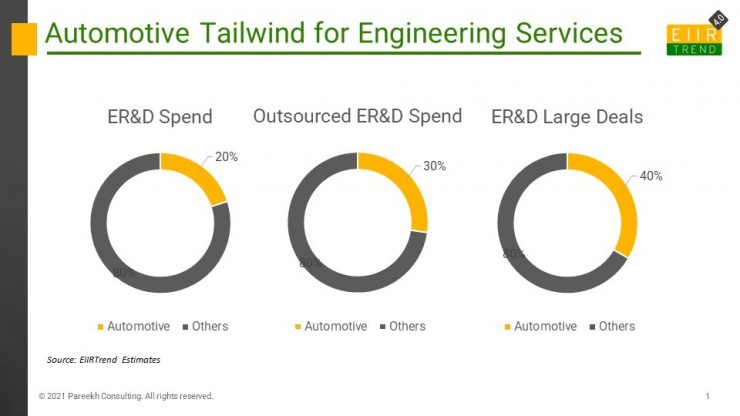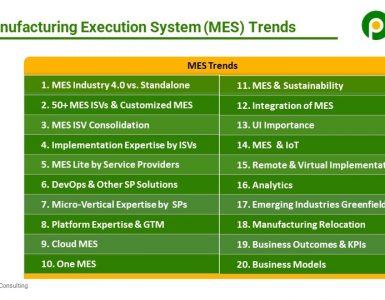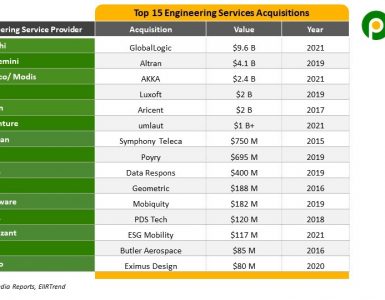There is a paradox. Though the automotive industry is facing headwinds, the automotive industry is providing tailwinds for engineering service providers.
The importance of automotive for engineering services can be gauged from the below exhibit. Automotive has a good proportion of total engineering spend, but a high proportion of engineering outsourcing spend and an even higher proportion of engineering large deals.

Automotive industry headwinds
The automotive industry is facing one headwind after another. Even before the onset of the coronavirus pandemic, the global automotive market was slowing down and struggling. Then corona lockdowns hit production and also consumption. As automotive started recovering this year, now there is a chip shortage.
Why automotive is a tailwind for engineering services?
R&D challenges faced by auto manufacturers and their suppliers are:
- Disruptors are raising the bar. Tesla has taken pole position in the EV industry and trying hard for AV. Software giants either have taken or are in the process of taking bets in the automotive sector. Google has launched Waymo. Amazon invested in Rivian. Apple is thinking about Apple Car. Ola has entered the electric scooter market. And these disruptors are investing big in automotive R&D as they invest in software R&D. Traditionally, automotive firms used to spend about 3-7% of revenues in R&D. Now disruptors are investing in double digits in R&D, and they have deep pockets to raise the bar further.
- Technology investment with declining budgets. Incumbent auto firms need to spend more on new technologies, be it connected, autonomous, shared, and electric (CASE). Simultaneously they need to continue investing in ICE technologies for efficiency, reducing emissions for few more years. Also, they need to plan other technology investment as light-weighting, hydrogen, more safety, security, and other new features and possibilities. Auto firms have to invest in all of these while their R&D budgets are not increasing or even declining.
- Different kinds of talent requirements. Now the car is a data center on the wheel. It needs a different type of talent with more software and digital focus. Auto firms are not necessarily the top choice for digital or software engineers.
- Business restructuring including M&As. Auto firms are restructuring their businesses to improve their competitiveness and position in the market. There were many large M&As both in OEMs and tier-1s such as FCA PSA, ZF Wabco, Marelli – Calsonic, Faurecia – Hella Veoneer either Magna or Qualcomm. One of the aftereffects of M&As is the consolidation of product lines, platforms, and R&D programs to realize synergy.
- Access to a large ecosystem. New players/ startups are emerging in new areas both in the auto industry and its adjacencies. Auto firms need to keep track of them, partner, or collaborate with them where needed in order to be relevant in changing technology landscape.
- Digitalization. Apart from vehicles or product-related technology investments, auto firms need to invest in digitalization in manufacturing, including Industry 4.0. Also, digital investments are required for supporting functions such as supply chain, procurement, customer sales, etc. Many firms are experimenting with different as-a-service business models. All of this requires skills and expertise which auto firms may not have internally.
- Sustainability: Vehicles are one of the major sources of emission. Auto firms need to improve both vehicle mix and efficiency for energy and emissions both for regulatory and corporate social responsibility reasons. They also need to look at incorporating sustainability in their manufacturing and other internal processes. They will need external help in starting and scaling sustainability initiatives.
Auto companies should look to optimize their R&D portfolio to overcome the above challenges. Automotive enterprises need to reevaluate their strategic R&D options based on three dimensions: investment requirement, short-term returns, and long-term returns, as shown in the below exhibit.

As seen above, the solution to many of the challenges of auto enterprises is outsourcing and partnering with engineering service providers, be it for skills, cost, time-to-market, monetization, or even slow spending on long-term trends.
Pandemic has removed many artificial constraints of what can or can’t be outsourced. So automotive engineering outsourcing and offshoring are bound to increase. And this is reflected in recent market information, be it large deals or stock prices of pureplay engineering service providers with strong automotive portfolios.
Bottom line: The need of auto firms to navigate their challenges better, faster, and in a cost-effective way is creating a tailwind for automotive engineering services. More engineering service providers should double down on automotive with investments and capability development to take advantage of this.






 Pareekh Jain
Founder of Pareekh Consulting & EIIRTrends
Pareekh Jain
Founder of Pareekh Consulting & EIIRTrends
Add comment